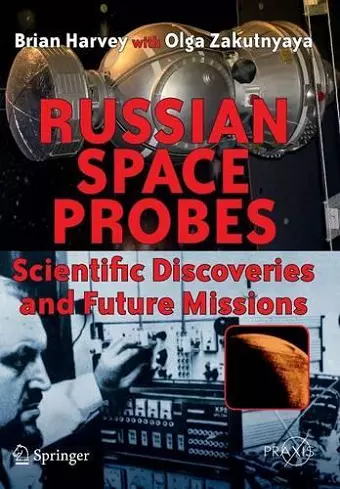Russian Space Probes
Scientific Discoveries and Future Missions
Brian Harvey author Olga Zakutnyaya author
Format:Paperback
Publisher:Springer-Verlag New York Inc.
Published:6th May '11
Currently unavailable, our supplier has not provided us a restock date

Brian Harvey recounts for the first time the definitive history of scientific Russian space probes and the knowledge they acquired of the Earth, its environment, the Moon, Mars and Venus. He examines what Russian Space Science has actually achieved in furthering our knowledge of the Solar System, focusing on the instrumentation and scientific objectives and outcomes, the information gained and lessons learnt. Boxes and charts are used extensively in order to convey in an easily understandable manner for the non-scientific reader the problems and issues addressed and solved by Soviet space science. The book opens with the story of early space science in Russia, which started when the first Russian rockets were fired into the high atmosphere from Kapustin Yar in the late 1940s. Instruments were carried to measure and map the atmosphere and later rockets carried dogs to test their reactions to weightlessness. In order to beat America into Earth orbit, two simpler satellites than originally planned were launched, Sputnik and Sputnik 2, which provided some initial information on atmospheric density, while the following Sputnik 3 carried twelve instruments to measure radiation belts, solar radiation, the density of the atmosphere and the Earth’s magnetic field. The author recounts how, by the 1960s, the Soviet Union had developed a program of investigation of near-Earth space using satellites within the Cosmos program, in particular the DS (Dnepropetrovsky Sputnik), small satellites developed to investigate meteoroids, radiation, the magnetic fields, the upper atmosphere, solar activity, ionosphere, charged particles, cosmic rays and geophysics. Brian Harvey then gives the scientific results from Russian lunar exploration, starting with the discovery of the solar wind by the First Cosmic Ship and the initial mapping of the lunar far side by the Automatic Interplanetary Station. He describes Luna 10, which made the first full study of the lunar environment, Luna 16 which brought soil back to Earth and the two Moon rovers which travelled 50 kms across the lunar surface taking thousands of measurements, soil analyses and photographs, as well as profiles of discrete areas. Chapters 4 and 5 describe in detail the scientific outcomes of the missions to Venus and Mars, before considering the orbiting space stations in Chapter 6. Space science formed an important part of the early manned space program,...
From the reviews:
“This well-researched book begins with a discussion of early Soviet balloon flights, followed by coverage of the Sputnik era and the Soviet lunar, Venus, and Mars probes. Harvey … and Zakutnyaya, a science journalist, provide good descriptions of numerous Soviet experiments related to space biology and materials science. … Overall, the book provides an excellent account of the extensive scientific results/accomplishments of Soviet space programs. … An important contribution to the history of space science. Summing Up: Highly recommended. All readers.” (A. M. Strauss, Choice, Vol. 49 (3), November, 2011)
“The country’s descent from technological and scientific dominance is clearly demonstrated by this book, which summarizes in considerable depth the scientific missions and discoveries made by the former Soviet Union. … the entire book is taken up with descriptions of scientific endeavours undertaken during the 1960s and 1970s. … This well-researched volume provides a valuable account of many experiments and missions which have previously been poorly documented in the West.” (Peter Bond, The Observatory, Vol. 132 (1227), April, 2012)
ISBN: 9781441981493
Dimensions: unknown
Weight: unknown
514 pages